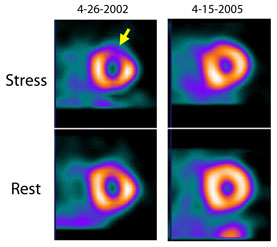The most promising drugs in the pipeline for primary care
An expert sorts through the drug research pipeline to find novel medicines that are relevant to internal medicine, including rivaroxaban for VTE, telcagepant for migraines and anacetrapib for increasing HDL.
MIAMI —The FDA approved more than 50 new drugs in 2008. But not one is really new or relevant to primary care, said Gerald W. Smetana, MD. In fact, to prepare for his update on new drugs at the annual meeting of the Society for General Internal Medicine, he had to dig through the literature and find some not-yet-approved drugs.

“These are the drugs that are novel, relevant to us, and not me-too drugs the ones that I thought are the most important drugs in the pipeline,” he explained to attendees at the May meeting. (Dr. Smetana reported no conflicts of interest with the drugs he discussed.)
The most exciting of these new therapies, and the most likely to hit the market soon, is rivaroxaban, a medication to prevent postoperative venous thromboembolism (VTE). “If you're paying attention to the major journals, it's hard not to notice rivaroxaban. There's been a flurry of reports,” said Dr. Smetana, associate professor of medicine at Harvard Medical School.
From those reports, it appears that rivaroxaban may be a good alternative to current therapies, said Dr. Smetana. “Unfractionated heparin requires a hospital stay, low molecular weight heparin requires injections and is very expensive, warfarin has a very narrow therapeutic range and requires frequent monitoring.”
Rivaroxaban, a factor Xa inhibitor, corrects many of those problems. It can be given as a once-daily medication, and has rapid onset, a half-life of about five to nine hours and a predictable anti-coagulant response, so it doesn't require monitoring.
Several large trials have been conducted comparing the new drug to enoxaparin in patients receiving hip and knee replacements. In all of the trials, rivaroxaban resulted in decreased postoperative VTE rates (between 31% and 79% lower) and similar incidences of bleeding (Lancet 2008; 372:6).
“If this drug proves to be effective for a variety of indications, this could really change everything. It could eliminate warfarin clinics,” Dr. Smetana said.
Although firm evidence for the new medication comes from trials of VTE prophylaxis, there are suggestions that it could be useful for other anti-coagulant purposes. A non-inferiority trial compared rivaroxaban to low molecular weight heparin for the treatment of deep vein thrombosis, and found it to be more effective (Blood 2008; July 18 e-pub). “It's tantalizing. It suggests there might be a similar beneficial effect, but we don't have the data,” he said.
Atrial fibrillation could be another potential application, but clinicians will have to wait for more trials to see how rivaroxaban fares in that condition. They likely won't have to wait long for the drug itself, though, because it could be approved within the next few months.
The cost is still unknown, but an anti-coagulant treatment that eliminated the need for monitoring could prove very cost effective, Dr. Smetana noted.
Physicians and patients will have to be a little more patient in their wait for the latest in migraine therapies. Telcagepant has been through Phase III trials, but has not yet been submitted to the FDA, so it won't have the potential to hit the market for at least a year or two, Dr. Smetana said.
Telcagepant targets the neurogenic inflammation associated with migraine, specifically, calcitonin gene-related peptide (CGRP). As a CGRP receptor antagonist, the drug has the potential to treat migraines without the side effects of some current therapies.
“The CGRP antagonists have no direct vasoconstrictive properties so it's possible that they have potential for no cardiovascular side effects. In that regard, they're different from the triptans,” said Dr. Smetana.
Trials have compared the new drug with rizatriptan and found it to have similar effectiveness. In a Phase III trial of healthy adults with moderate to severe migraines, 300 mg of telcagepant resulted in 26.9% of patients being pain-free in two hours, compared with 31.3% of those taking zolmitriptan. Less than 10% of those taking a placebo got relief.
Telcagepant had similar rates to placebo for side effects (about 30%) while about half of patients taking the triptan reported side effects (Lancet 2008; 372:2115). “The rationale for developing this drug was that if it's equally effective for acute treatment of migraine, with fewer side effects, it might be an attractive option,” said Dr. Smetana.
More data, particularly on long-term safety, are still to come but are expected to be good, he noted. “It's unlikely there are going to be unanticipated side effects in my view because this is given as a single-dose treatment rather than long-term daily therapy.”
If approved and priced reasonably, telecagepant could make sense as a second-line treatment in patients for whom non-steroidals don't work, Dr. Smetana said. It could be particularly useful in patients who don't tolerate triptans or have cardiovascular risk factors.
Cardiovascular risk is the target of the third and final drug that Dr. Smetana covered in his lecture. Anacetrapib is a cholesterol ester transfer protein (CETP) inhibitor. Torcetrapib was the first CETP inhibitor to show promise in increasing HDL levels, but it also turned out to increase cardiovascular morbidity.
“This was very disappointing because there was a lot of hope,” said Dr. Smetana. “The question is why would there be increased cardiovascular morbidity in a drug that raised HDL?”
Researchers are hoping that the answer is an off-target effect. Studies showed that torcetrapib decreased serum potassium levels and increased systolic blood pressure consistent with an aldosterone like effect. So far, trials of anacetrapib have indicated that it offers the benefits, but not the downsides, of torcetrapib.
In Phase II studies, higher doses of the drug resulted in over 100% increases in patients' HDL levels. It was compared against and combined with atorvastatin and there did not appear to be any adverse effect on blood pressure (Am Heart J 2009; 157:32).
“We don't, however, have any studies looking at hard cardiovascular endpoints from this drug,” said Dr. Smetana. Further trials, which would be needed for FDA approval, should answer some of the questions about the cardiovascular effects of the drug, and help physicians judge its value.
“I'm suggesting great caution with this medication. We really need much larger Phase III trials that are going to look at cardiovascular endpoints before making a decision,” Dr. Smetana said. Sounds like a potential topic for next year's update.





